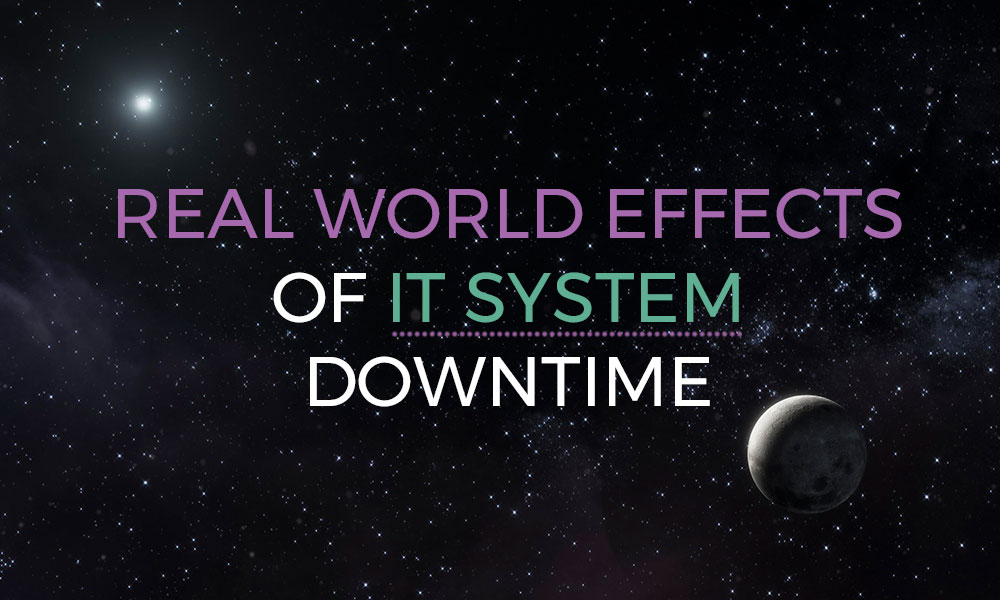Can we quantify the costs of IT system downtime? A few years ago, Gartner did just that and calculated the average cost of network downtime to be a whopping $5,600 per minute! (£4,017) Gartner first came up with its calculation in 2014, and it’s fair to say that all businesses have become significantly more reliant on technology since then.
In 2014 there were far more on-premise solutions, and far less data was sent to the Cloud. Everything from back-office processes to e-commerce to internal and external communications now rely even more heavily on IT systems than ever before, and needs to be running and fully functional 24/7. Otherwise, the business will risk its credibility, loss of productivity, loss of revenue, and possibly the short and long-term efficacy of the entire operation!
“The average cost of network downtime is calculated to be over £4k per minute!”
Lost productivity
Extended IT downtime is no longer an option for modern businesses – when IT stops, business stops too. If your network goes down, you can’t communicate with potential customers, sell services, or collaborate with your teams. You can still make a cup of tea, or busy your team with less essential tasks, but that’s about it and that means lost money…
“When IT stops, business stops too!”
And if downtime becomes more of a regular occurrence than a one-off, staff will start to get frustrated and lose morale, which could lead to even more lost productivity lost and even good staff looking elsewhere!
Especially in certain industries like financial services, public services, armed forces and others, outages impact more than just the productivity of staff and can have real-world consequences.
Which is why it’s important to call on experienced IT professionals, either in-house or via an MSP – Managed Service Provider. This enables you to hand-off all these complex considerations and focus on running your business.
“A Managed Service Provider will help prevent recurring downtime, so you can focus on running your business!”
Downtime cost
Now imagine the impact of downtime at a critical moment. Maybe your EPoS machines go down on the Saturday before Christmas, or your telephony system fails at the start of a cold calling campaign…
If you’re B2B, think about a failed update corrupting your accounting software, causing data loss during peak selling season. Imagine your website going down, just when you start a PPC advertising campaign.
These are not so many hiccups as (in business terms at least) minor catastrophes that will cost your business money. Therefore, it’s no wonder that the pandemic led to an increase in IT outsourcing. Equipping home workers during lockdown – and the increase in online sales – was a timely reminder to businesses of all sizes of just how vital their IT systems are.
So, what can you do to prevent these sorts of issues in the long-term, or minimise downtime, should the worst happen?
Disaster Recovery plan
The most important thing you need to consider, even for smaller businesses, is having a plan in place for any outage that you may experience.
Whether through a natural disaster, cut cable or missed bill, how will you deal with no power to your building?
If your phone lines go down, can staff call from their mobiles without having to share their personal number?
Does the business have a back-up internet connection, either fixed-line or 4G and sometimes known as a ‘fail-over’, if your network goes dark and can’t be fixed until next week?
Again, if you’re not sure what process you need to recover from these types of scenarios, an experienced Managed Service Provider will be able to identify which situations you need to plan for, and the best processes to overcome them.
Planned outages
Especially if your business leverages Cloud services, or stores information in a data center, it’s important to stay up to date across any scheduled downtime.
Hardware and software both need updating every so often, and any Cloud providers worth their salt will let you know if there are any planned outages, usually called ‘Planned Maintenance’.
So, make sure your team is aware and that any tasks that wouldn’t be possible during the outage are performed beforehand to ensure no unnecessary dips in productivity.
Hardware failure
Whether it’s a dropped phone, operating system issue, network service outage or a laptop that’s a little too old, sometimes things break and usually at the worst possible time.
Thankfully, many internet providers also offer Service Level Agreements (SLA) on their business-specific connections, meaning a guaranteed fix within a number of hours or days, depending on how vital your connection is to the operation and how much you want to spend.
It’s also best practice to have a spare laptop and handset available, should the worst happen. Having any computers automatically back-up to a Server, or keeping that data in the Cloud originally, are ideal ways to ensure you don’t lose any data too.
All in all, downtime costs companies time and money. Working with a Managed Service Provider like Mooncomputers means you won’t have to worry about any of this, we’ll do it for you.
With over 20 years’ experience, there isn’t a challenge too large or too small that we can’t help you overcome. If you need support, get in touch or call us on 01604 879 330 to discover a better future, free of downtime and lost revenue.



